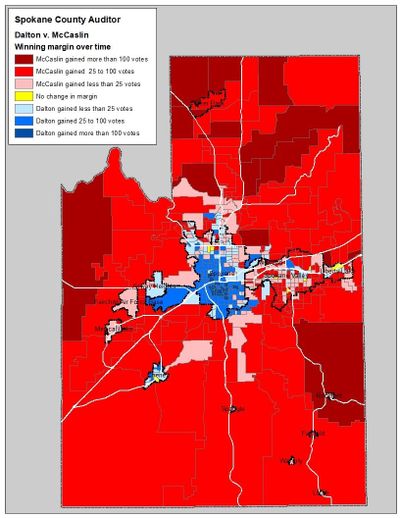Spin Control: Elections are won on the margins, and Dalton’s were just a bit better

Spokane County Auditor Vicky Dalton owes her re-election to heavy voting precincts in the city of Spokane. Her Republican challenger, Bob McCaslin, almost caught her thanks to vote margins in or near parts of his old legislative district.
The race for county auditor is usually what is technically referred to as a “snoozer” in political circles, especially when it involves an incumbent seeking re-election. This year, it was the closest election in the Spokane area and wasn’t decided until last week when almost all the ballots had been processed.
Dalton was ahead by 5,724 votes on Election Night. A generation ago when most Spokane residents voted at poll sites, that would have been enough to call the race for her, even though absentee ballots in those days trended Republican.
With all-mail voting, the ballots counted on Election Night are the ones deposited in drop boxes or mailed in before the final weekend. Ballots counted in the days after the election are those mailed or deposited as Nov. 8 approached, and the last were those mailed close to or on that day that made their way to the Elections Office by last week. The later ballots usually trend Republican, although this year showed signs that trend may be easing.
McCaslin steadily gained ground in those later tabulations, so that by last Monday, the gap was down to 932 votes. When the last large batch of votes was counted last Thursday; however, the count had swung back in Dalton’s favor and she finished 1,242 votes ahead.
In other words, McCaslin made up nearly 4,450 votes over those nine days. But he didn’t gain them and Dalton didn’t lose them uniformly throughout the county, a computer analysis of the shifting vote totals within the precincts shows.
The number of voters in Spokane County’s 439 precincts varies considerably, as did the voter turnout for this year’s general election. About 39% of the county’s ballots were counted on Election Night, but by Thursday, that turnout had risen to 61.7%
The number of votes each candidate received in those precincts changed with each tally. The winning margins went up or down and sometimes even switched from one candidate to the other. In only a handful of precincts was the margin between the two candidates the same in Thursday’s count as it was on Election Night.
By analyzing and mapping the change in the margin of votes for the winning candidate in each precinct between Nov. 8 and last Thursday, a pattern appears for the shifts that allowed McCaslin to come close but for Dalton to win eventually.
A four-term legislator from Spokane’s 4th District, McCaslin collected some of his biggest margins in or near his old district, gaining ground through lopsided wins in rural areas near Mount Spokane and Green Bluff, precincts near Liberty Lake and a rural district surrounding Rockford. He gained on Dalton in most rural precincts, including by large margins on much of the West Plains.
But while McCaslin carried most of the precincts in the cities of Spokane Valley and Liberty Lake, his margins did not increase as much as he needed to pass Dalton in the final count. In some of those precincts the margin between the two candidates changed by two dozen votes or less.
Dalton carried most City of Spokane precincts in the Election Night count and was able to increase her winning margins significantly in downtown and most South Hill precincts – often by more than 100 votes per precinct – and by smaller margins in many North Side precincts as the counts continued. She also offset some of McCaslin’s gains by increasing her margins in most Cheney and some Airway Heights precincts.
There’s nothing suspicious or nefarious about any of this. There were no precincts that flipped from overwhelmingly McCaslin to overwhelmingly Dalton, or vice versa, as the count went on. For the most part, the deep red Republican precincts stayed crimson, dark blue Democratic precincts stayed indigo.
But elections are won on the margins, or how many more votes a candidate pulls out of a precinct than their opponent when the counting is done. Dalton saw her margins increase by more than 100 votes in 15 precincts compared to 14 for McCaslin, but he saw his margins increase between 50 and 100 votes in 68 precincts compared to 39 precincts for her. That was enough for him to come close, but not to win.
One more election note
Spokane County turnout was 61.7%, which is slightly less than two out of every three voters but still very good for a mid-term election. One can argue whether higher turnout would have helped the losers or made the days of counting more comfortable for the winners. That probably depends on the race.
In the auditor’s race, for example, both Dalton and McCaslin did well in some high-turnout precincts, although both probably wish that more voters in certain areas – the city of Spokane’s North Side, in Dalton’s case and the city of Spokane Valley in McCaslin’s – had a better showing.
But because the number of voters varies among the precincts, a high turnout in some precincts can be a few dozen voters or less. There were some “vote-rich” precincts in the general election, with Dalton carrying the packed precincts on the South Hill and McCaslin winning big in some precincts north of the city of Spokane along Highways 395 and 2.